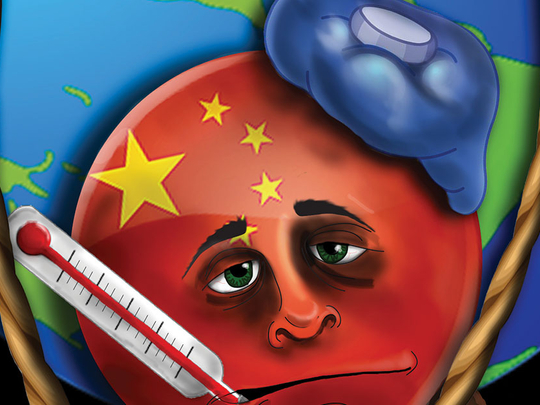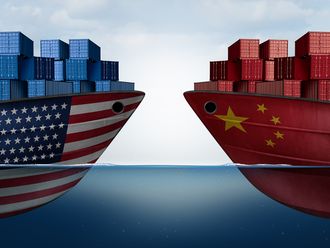
According to a modern version of Metternich’s saying, when the US sneezes, the rest of the world catches a cold. Does the same now apply to the world’s second-largest economy?
If China implodes, could it drag down the global economy with it? China’s stock market has fallen by about a third since the middle of July, and it has devalued its currency — not once but twice, sending shock waves through financial markets.
Despite the seeming panic, so far prices have only fallen back to the same levels as at the end of March. In any case, fewer than one in 10 Chinese households invest in stocks and shares, and on average the stock market accounts for less than 15 per cent of household wealth.
So the tens of millions of small Chinese investors who play the stock market have mostly been betting relatively small amounts and haven’t lost their shirts. And yet the current situation is worrying.
China’s exports have plummeted by more than 8 per cent in the past year, partially thanks to the renminbi being pegged to a rising dollar. A widespread loss of confidence could be very harmful for the economy, which is why the government has stepped in with some heavy-handed measures to stabilise the market, of which currency devaluation is only the latest example.
The measure is partially a symbolic response to the IMF stating that China wasn’t ready to be a global reserve currency: a gesture to show that the renminbi is becoming more flexible. The immediate effect, though, has been to compound the global markets’ worries about Chinese growth — and to add a new one.
Will China go so far as to launch a currency war to boost its growth? China’s economy is at a crossroads. The government says that slowing growth is consistent with its plan to restructure the economy.
Others worry that the slowest growth rate for 20 years is a sign of a prolonged structural slowdown. After three decades of rapid growth, China is now approaching the so-called “middle-income country trap”: a dramatic slowing of an economy after it has reached upper middle-income status, which at present is around $14,000 per capita.
History is littered with examples of countries such as Argentina, where growth slows so much that they never join the ranks of the rich. The Organisation for Economic Cooperation and Development estimates that only a dozen or so countries, such as South Korea and states in southern Europe including Spain and Italy, have escaped this trap in the post-war period.
Some dispute whether such a trap exists, but it’s not a risk that Chinese policymakers are willing to take. Its leaders view the slowing economy not as one that is losing momentum, but one making a necessary transition to a more sustainable path — relying more on the domestic consumer and less on the foreign one.
The 2008 financial crisis showed the downside of being an export-oriented economy when millions of workers lost their jobs as global demand slumped. China is already the world’s largest exporter and isn’t expecting to gain more market share.
Exports will no longer be the growth driver. With its own newly formed middle-class, China now has its own consumption base to serve.
Consumption as a share of national output has increased in recent years from 35 per cent to about 50 per cent. For most advanced countries, consumption is around half- to two-thirds of national output.
So the well-known Chinese saver is now becoming more of a spender. China, often referred to as the factory of the world, is also rebalancing away from manufacturing.
Services have risen quickly to become the largest part of the economy, demand being driven by the fast-growing urban population.
For China to emulate its neighbours Japan and South Korea, and break out of the middle-income trap, it will have to raise productivity and innovation.
Technological progress and globally competitive companies are the hallmark of prosperous nations. China has a few, but most sectors operate within rather than at the edge of the technological frontier.
To achieve this, reform of legal and regulatory institutions, as well as scaling back the inefficient state-owned sector, are all needed. This takes time, especially as vested interests and culture must also change. With an ageing population, achieving more output from existing workers becomes an imperative.
Without it, the economy will continue to slow and its well-known high level of debt — much of which is owed by local governments — will become unsustainable.
That could trigger a bust. China’s slowdown is already being felt around the world, contributing to a slump in commodity prices.
Oil companies have announced thousands of job cuts. And if Chinese consumers stop buying, it will affect a multitude of western and Asian companies selling to the aspiring middle-class.
Apple’s record results have been driven by iPhone sales in China, which has overtaken the US market. BMW is yet another company to issue a warning about the impact of a Chinese slowdown.
China’s financial system isn’t integrated with the rest of the world in the way the US’s was when the Lehmans collapse triggered a crash in the global banking system. But it is increasingly connected, such as through the renminbi hubs that trade the Chinese currency located around the world.
A deep slump will certainly affect global demand and economic growth, perhaps even enough to trigger recessions in some of its trading partners. So if China gets the sniffles, then the rest of the world should probably keep the tissues handy.
— Guardian News & Media Ltd












